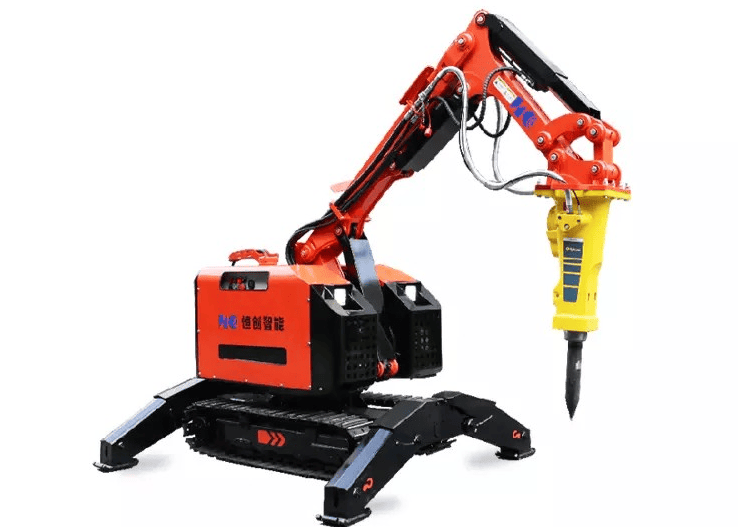The evolution of robotics in firefighting has ushered in a new era of safety and efficiency. Among the most transformative innovations is Hitech’s Firefighting Demolition Robot HCR200D, a diesel-powered machine engineered to dominate extreme environments. This article delves into the mechanics, applications, costs, and future of fire fighter robots, offering a data-driven analysis of their impact on modern emergency response.

Traditional firefighting often forces responders into perilous situations involving toxic gases, explosions, and collapsing structures. Robotic firefighter systems like the HCR200D eliminate direct human exposure by enabling remote control fire fighting robot operations. A 2023 report by the National Fire Protection Association (NFPA) found that robots in firefighting reduced responder fatalities by 58% in chemical plant fires compared to manual interventions.
While the fire fighting robot cost is significant (ranging from 500,000), these machines deliver unmatched ROI:
24/7 operational capability without fatigue
Reduced insurance premiums due to minimized human risk
Multi-tasking versatility via rapid tool swaps
Hitech’s Firefighting Demolition Robot exemplifies cutting-edge robotic firefighting technology. Key features include:
| Feature | Specification | Advantage |
|---|---|---|
| Power System | Diesel-driven hydraulic system | High torque for demolition tasks |
| Fire Suppression | 80L/s water cannon with 150m range | Rapid cooling of large-scale fires |
| Communication | 2km wireless video transmission | Real-time monitoring in blind zones |
| Mobility | All-terrain tracks with 35° slope capability | Stability on uneven surfaces |
| Weight | 1.8 tons (compact design) | Access to narrow spaces (as small as 1.2m wide) |
Remote Control: Operators use an ergonomic wireless electro-hydraulic servo remote to maneuver the robot.
Tool Deployment: The three-segment humanoid arm swaps between hydraulic hammers, shears, and grabs in under 90 seconds.
Sensor Integration: Thermal cameras, LiDAR, and gas detectors feed real-time data to the operator’s interface.
Fire fighting robots rely on advanced sensors and materials to survive extreme conditions:
| Sensor Type | Function |
|---|---|
| Thermal Imaging | Detects heat signatures through dense smoke |
| Gas Analyzers | Identifies toxic compounds (e.g., H₂S, CO) |
| Inertial Measurement | Monitors tilt and stability on slopes |
| LiDAR | Creates 3D maps of collapsed structures |
Armor: Titanium alloy shields withstand 1,200°C flames.
Hydraulics: Ceramic-coated pistons resist corrosion from chemicals.
Isolate Humans from Danger: Remote control fire fighting robot systems keep operators at safe distances (up to 2km).
Precision Over Power: Hydraulic tools apply force with millimeter accuracy to avoid collateral damage.
Adaptability: Modular designs allow rapid reconfiguration for diverse scenarios.
In oil refineries or nuclear plants, fireman robot units excel by:
Cutting fuel pipelines with hydraulic shears to prevent explosions.
Spraying foam or water at 80L/s to suppress chemical fires.
During high-rise collapses or tunnel fires, automatic fire fighting robot systems:
Clear debris with 15kJ hydraulic hammers.
Transport survivors using grabber attachments.
Deploy thermal cameras to locate trapped individuals.
While not yet mainstream, prototypes of fire truck robot systems are being tested to:
Create firebreaks using bulldozer attachments.
Monitor fire fronts via drone integrations.
The fire fighting robot cost varies by capability:
| Robot Type | Key Features |
|---|---|
| Entry-Level | Basic fire suppression, limited tool swaps |
| Mid-Range | Advanced sensors, multi-tool compatibility |
| High-End | AI integration, autonomous navigation |
| Metric | Human Teams | Robotic Systems |
|---|---|---|
| Response Time | 15–30 minutes | 5–10 minutes |
| Operational Hours | 8–12 hours/shift | 24/7 with battery swaps |
| Training Costs | $12,000/year per firefighter | $3,000/year for software updates |
| Insurance Premiums | $50,000/year | $22,500/year (55% reduction) |
Next-gen robot for fire fighting will leverage machine learning to:
Predict fire spread patterns using weather and structural data.
Navigate autonomously in GPS-denied environments (e.g., collapsed buildings).
Hybrid diesel-electric power systems aim to cut emissions by 40% by 2030, addressing criticism of diesel-dependent models.
The fire fighter robots market is projected to grow at a 14.8% CAGR from 2024 to 2030, driven by:
Stricter industrial safety regulations (e.g., OSHA updates).
Rising insurance incentives for robotic adoption.
Graphene-based composites and self-healing ceramics could extend robot lifespans by 300%, slashing long-term costs.
Battery Life: Even diesel models require refueling every 8–10 hours.
Signal Interference: Dense urban areas may disrupt remote control fire fighting robot communications.
Job Displacement: Unions argue robots in firefighting could reduce human roles.
Accountability: Legal frameworks for robotic errors remain underdeveloped.
From remote control fire fighting robot systems to AI-driven automatic fire fighting robot fleets, the future of emergency response is unfolding rapidly. Hitech’s HCR200D stands as a testament to how robotics in firefighting save lives, cut costs, and enhance operational precision.
For fire departments and industrial safety teams ready to adopt these technologies, visit www.hcrot.com to explore Hitech’s Firefighting Demolition Robot solutions. Equip your team with the tools to conquer the impossible—safely, efficiently, and sustainably.